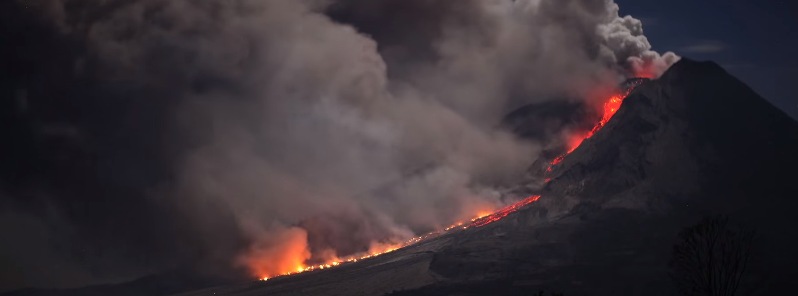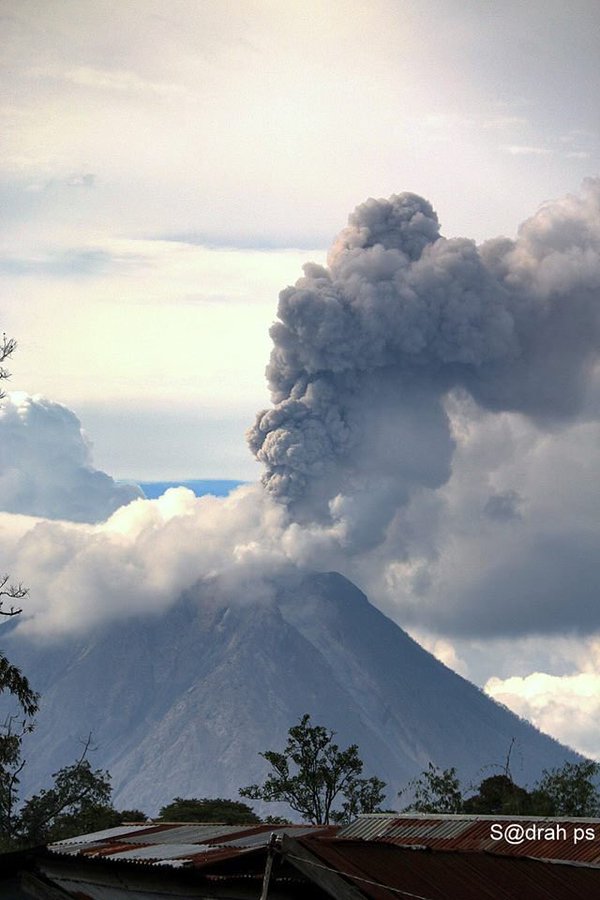Eruption of Mount Sinabung continues

In August 2010, Indonesia's Sinabung volcano roared back to life with its first eruption in known history. The volcano emitted diffuse white plumes that rose 20 m (65 feet) above the crater and showed signs of increased activity on August 28.
On August 29, rumbling sounds coming from the volcano prompted authorities to contact and move people living within 5 km (3.1 miles) radius from the volcano. Later that day, an explosion produced an ash plume that rose 1.5 km (4 920 feet) above the crater (3 960 m (12 992 feet) above the sea level), and Alert Level was raised to 4 (on a scale of 1 to 4).
The next day, a second, more powerful, eruption generated an ash plume that rose 2 km (5 561 feet) above the crater. Ashfall and strong sulfur odor was reported in nearby areas. Media reports mentioned the number of evacuated people ranged from 20 000 to 30 000.
Seismicity at Sinabung fluctuated until September 2013, when dense white plumes started rising 100 to 150 m (328 to 492 feet) above the crater.
Sinabung's first major eruption in known history occurred on September 17, 2013. According to the Darwin VAAC, a pilot observed an ash plume rising to an altitude of 6.1 km (20 000 feet) above the sea level and drifting 55 km (34.2 miles) to the southeast.

Video courtesy of VolcanoDiscovery
Series of eruptions that followed in the months ahead completely changed the landscape around the volcano and the lives of thousands of people living on its slopes.
Powerful explosion at Mount Sinabung sends plume of ash 6 km into the air, Indonesia
A powerful new explosion occurred at Mount Sinabung on Tuesday, September 17, sending a plume of ash about 6 km (19 658 feet) into the air. As of Monday, September 16, a total of 6 259 people have been evacuated from surrounding villages. Read more…
September 17, 2013
Another major eruption of Indonesian Mount Sinabung volcano
Indonesian Mount Sinabung volcano erupted in September 2013 for the first time in three years and has been erupting intermittently ever since. The 2 475 m (8 120 ft) high volcano erupted violently again early Sunday, November 3, unleashing… Read more…
November 04, 2013
Sinabung erupts sending ash plume to about 9 km altitude, Indonesia
Another strong explosion occurred this morning at Indonesian Sinabung volcano. Ash plume was sent to about 9 km (30 000 ft) altitude, according to Darwin VAAC, and drifted westward. The aviation alert level was raised to red. Read more…
November 18, 2013
Mount Sinabung on highest alert status after 9 powerful eruptions in one day, Indonesia
As of Saturday, November 23, 2013, the activity of Indonesia's Mount Sinabung is on the rise again. 9 strong explosions… Read more…
November 24, 2013
Large eruption of Sinabung sends ash plume 12 km into the air
A large vulcanian explosion occurred at Indonesian Sinabung volcano on December 10, 2013 at 04:30 UTC. Darwin VAAC reported ash plume rose to an altitude of 12 km (38 000 feet) and drifted 92.6 km (57.5 miles) to the NW. Read more…
December 10, 2013
Strong eruption of Mount Sinabung triggers more evacuations, preparing for worst-case scenario
Indonesian authorities are reporting that activity at Mount Sinabung volcano is still very high. Current eruptive phase started on January 4, when at least 5 pyroclastic flows traveled down on the southeastern side and reached lengths of up to 4 km (2.5 miles). Read more…
January 05, 2014
Sinabung roars – largest pyroclastic flows, thick ash layer, major hazard from lahars
The eruption of Indonesian Sinabung volcano intensified again today and produced pyroclastic flows reaching more than 5 – 6 km in length (3.1 – 3.7 miles) , the largest so far. The associated ash plumes rose to an approximate altitude of 8 km (25 000 ft). Yesterday, the official… Read more…
January 14, 2014


Video courtesy PhotoVolcanica. January 22, 2014.
First direct victims
On February 1, 2014, several moderately large pyroclastic flows claimed lives of at least 14 people – the first direct victims of volcano's eruption. However, by that time, the ongoing eruptions have already claimed the lives of 31 evacuees, as a result of various illnesses such as breathing difficulties, depression, asthma and hypertension.
Deadly eruption of Mount Sinabung volcano claims its first victims, Indonesia
Indonesian Mount Sinabung volcano claimed its first victims due to a direct effect of the eruption. At least 14 people were reported killed and 3 others severely burnt by one or two moderately large pyroclastic flows this morning. 3 more people are still reported missing… Read more…
February 01, 2014


Video courtesy PhotoVolcanica. January 22, 2014.


Video courtesy Earth Uncut TV
Current situation
Ever since, the volcano's eruption continues with little changes. Slow lava extrusion at the summit results in occasional small to moderate pyroclastic flows.
PVMBG reported that during December 21 – 28, 2015 inclement weather sometimes prevented visual observations of Sinabung and the growing lava dome in the summit crater. As many as 21 hot avalanches and pyroclastic flows traveled 0.7 – 1.5 km (0.43 – 0.93) ESE, producing ash plumes that rose 1 km (3 280 feet). Ash plumes from explosions rose as high as 3 km (9 842 feet) and drifted E and SW. Seismicity consisted of avalanche and pyroclastic-flow signals, low-frequency and hybrid events, tremor, tectonic events, and volcanic earthquakes. Seismicity fluctuated at high levels, although it had declined compared to the previous week, and indicated lava-dome growth.
Based on information from PVMBG, ground reports, and satellite images, the Darwin VAAC reported that during January 6 – 12, 2016 ash plumes from Sinabung rose to altitudes of 3.7 – 4.3 km (12 000 – 14 000 feet) a.s.l. and drifted 15 – 40 km (9.3 – 24.8 miles) SW, W, NW, and NE.


Sinabung erupting on January 16, 2016. Image credit: #SadrahPS
The Alert Level remains at 4 (on a scale of 1 to 4), indicating that people within 7 km (4.3 miles) of the volcano on the SSE sector, and within 6 km (3.7 miles) in the ESE sector, should evacuate.
Geologic summary
Gunung Sinabung is a Pleistocene-to-Holocene stratovolcano with many lava flows on its flanks. The migration of summit vents along a N-S line gives the summit crater complex an elongated form. The youngest crater of this conical, 2 460-m-high (8 070 feet) andesitic-to-dacitic volcano is at the southern end of the four overlapping summit craters.
An unconfirmed eruption was noted in 1881, and solfataric activity was seen at the summit and upper flanks in 1912.
No confirmed historical eruptions were recorded prior to explosive eruptions during August – September 2010 that produced ash plumes to 5 km (16 404 feet) above the summit. (GVP)
Featured image: Sinabung's eruption in January 2014. Credit: Photovolcanica.

Commenting rules and guidelines
We value the thoughts and opinions of our readers and welcome healthy discussions on our website. In order to maintain a respectful and positive community, we ask that all commenters follow these rules:
We reserve the right to remove any comments that violate these rules. By commenting on our website, you agree to abide by these guidelines. Thank you for helping to create a positive and welcoming environment for all.